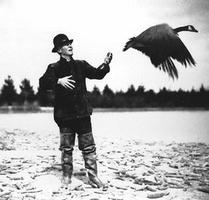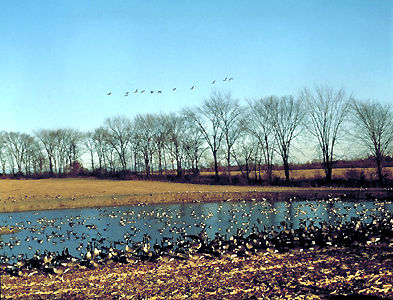Bird Sanctuaries and Reserves
At the turn of the century, with bird populations severely depleted by uncontrolled hunting, attempts to protect birds focused on the establishment of bird sanctuaries, areas in which hunting was prohibited at all times of the year. More recently, with hunting under control but with an increasing and industrialized human population encroaching on forests and wetlands, the focus has shifted to include protection of habitats.
Protection may be achieved by various means, including land-use zoning, long-term agreements with landowners and outright acquisition of land by wildlife agencies. Protected land areas may be designated as national wildlife areas, conservation areas, game reserves, etc. Where habitat protection is the main goal, hunting may be permitted or prohibited depending on circumstances at the site. Both types of protection seek the same end - conservation of Canada's heritage of birds and other wildlife.
Migratory Bird Sanctuaries
At present, 98 migratory bird sanctuaries are administered by the federal Canadian Wildlife Service : Newfoundland has 3; Prince Edward Island, one; Nova Scotia, 8; New Brunswick, 2; Québec, 33; Ontario, 10; Saskatchewan, 15; Alberta, 4; BC, 7; Northwest Territories, 5; and Nunavut 10. Of these, one straddles the Nunavut-Ontario border; another that of Nunavut-Québec. Some of the most renowned of these are described below.
Sable Island (NS)
The only breeding site of the rare Ipswich sparrow, it also has important populations of breeding gulls and terns.
Machias Seal Island (NB)
Home of many nesting seabirds, including Atlantic puffins, arctic terns, razorbills and Leach's storm-petrels.
Ile Bonaventure (Qué)
Spectacular concentrations of northern gannets, black-legged kittiwakes, common murres and other cliff-nesting seabirds.
Upper Canada (Ont)
Stopping-off area for Canada geese.
Last Mountain Lake (Sask)
The oldest bird sanctuary in North America celebrated its 100th birthday in 1987 with a dedication ceremony presided over by Prince Philip. It hosts many migrating ducks, geese, swans and cranes and is a breeding ground for sharp-tailed grouse, common terns, American avocets, mallards and many others.
George C. Reifel Migratory Bird Sanctuary (BC)
Now part of a complex of protected sites near the mouth of the Fraser River; this sanctuary harbours many species of waterfowl and shorebirds during migration and is used by wintering snow geese, American wigeon and American coots.
Bylot Island (Nunavut)
Greater snow geese nest on the southwestern outwash plain; thick-billed murres, black-legged kittiwakes and other seabirds nest on its northern and eastern shores.
Most provincial wildlife agencies have also established bird sanctuaries within their own boundaries; of particular importance are British Columbia's and Newfoundland's seabird sanctuaries and the pelican and grouse refuges in Manitoba, Saskatchewan and Alberta.
Wildlife Areas
Important migratory bird habitats are protected in the Canadian Wildlife Service's 49 National Wildlife Areas in 8 provinces and the 3 territories. They include the following well-known sites.
Tintamarre (NB)
This area of Tantramar Marsh at the head of Bay of Fundy is used by migrating and breeding waterfowl.
Cap-Tourmente (Qué)
Freshwater, tidal marsh and adjacent meadows harbour a high proportion of the world's greater snow geese during their migration.
Long Point (Ont)
Along the north shore of Lake Erie, and part of a complex of sites protected by federal, provincial and private organizations, this site is an exceptional gathering location for migrating songbirds and waterfowl.
Alaksen (BC)
This site is part of the Fraser River complex, which includes the Reifel Sanctuary.
Vaseaux Lake (BC)
Within the Okanagan Valley, this site protects a stopover of the trumpeter swan during its autumn migration.
Polar Bear Pass (Nunavut)
Located on Bathurst Island, this is the home of an impressive array of high arctic wildlife including, during the breeding season, such birds as snow geese, Brant, king eiders, rock ptarmigan, jaegers and several species of shorebirds.
Provincial wildlife agencies have also set aside several wildlife habitat areas, many chosen specifically for their variety and richness as bird habitats. Several other important bird areas are protected and managed jointly by federal and provincial wildlife departments. For example, in the Creston Valley Wildlife Management Area, BC, provincial and federal governments, in collaboration with private agencies and individuals, protect and manage a rich wetland area important to migrating waterfowl.
Other Protected Areas
Birds and their habitats are protected in Canada's national parks and in most provincial parks. Of special interest is Wood Buffalo National Park (Alberta-NWT border), the only known nesting area of the endangered whooping crane. Municipalities, private institutions, bird clubs and individuals have also done much to protect important areas, eg, Ile-aux-Basques, a nesting island for eiders, gulls and herons in the St Lawrence estuary, purchased in 1927 by the Provancher Society of Natural History; Jack Miner's Sanctuary (est 1904) near Kingsville, Ont, which has attracted flocks of Canada geese; and Alf Hole Goose Sanctuary near Rennie, Man.
Migratory birds regularly travel across national boundaries and must be considered an international heritage. In signing the Ramsar Convention for the Conservation of Wetlands of International Importance as Waterfowl Habitat (1981), Canada pledged to protect important wetlands, including such sites as Alaksen, Cap-Tourmente and the Queen Maud Gulf (Nunavut), an important breeding ground for Ross's, snow, and Brant geese and many other waterbirds. Canada now has wetlands of international importance designated under the Ramsar Convention, covering over 13 million hectares.
Although Canada enjoys an enviable reputation for establishing bird sanctuaries and reserves, reason for concern remains. Pollution, disturbance, habitat destruction and hunting continue to threaten bird populations.
See also Endangered Animals; Biosphere Reserves; Wildlife Conservation and Management; Wildlife Preserve.

 Share on Facebook
Share on Facebook Share on X
Share on X Share by Email
Share by Email Share on Google Classroom
Share on Google Classroom







